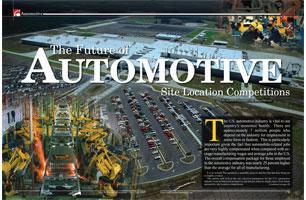

The U.S. automotive industry is vital to our country’s economic health. There are approximately 7 million people who depend on the industry for employment in some form or fashion. This is particularly important given the fact that automobile-related jobs are very highly compensated when compared with average manufacturing wages and average jobs in the U.S. The overall compensation package for those employed in the automotive industry was nearly 25 percent higher than the average for all of manufacturing.
It is no wonder that automotive assembly projects and the jobs that they bring are so highly coveted.
This article will look at the site selection parameters for the U.S. automotive industry from an historical perspective and discuss what we might expect from future automotive site location competitions.
The Midwest of the United States and Detroit, in particular, has been the home to the automobile since its inception. What used to be dubbed the Big 3 is now commonly referred to as the Detroit 3 – GM, Ford, and Chrysler, which was bought by Daimler of Germany in 1998. The domestic automakers have hit rough patches before but never have they been under such assault as at present. Competition from foreign automakers is making the restructuring of GM and Ford hard as they continue to lose market share.
The influx of foreign auto manufacturers officially began in 1982 with Honda locating a plant in Marysville, OH. The international manufacturers, or transplants as they are sometimes referred to, wanted to build cars closer to their markets and have therefore continued to build plants in North America has they have captured more of that market share. As such, the past few years have seen a record number of new plant announcements by the foreign companies. Toyota and Honda are leading the charge as the largest foreign sellers with Nissan following close behind.
That is not expected to slow down in the near future…
Toyota has a publicly stated goal of building at least 60% of the vehicles it sells in North America in North American facilities. The company has been setting new sales records lately and is trying to keep up with the demand. If their sales continue to keep pace with current growth they will almost certainly have to add capacity in order to keep that goal.
Honda has seen growth by relying on two well-made models – the Accord and Civic. According to the Automotive News 2007 North American Production and Sales projections, Honda will have sales in North America that exceed their production capacity even after the new plant in Greenberg, Indiana comes on line.
Nissan was the second transplant from Japan in 1983 and currently has four plants in North America. The company has seen about the same amount of sales growth since 2002 as Honda, and will be on the same track in the near future.
The Korean partners Hyundai and Kia have both announced new capacity in the U.S in recent years. The new Kia plant is moving forward as planned according to both the company and the state of Georgia. The sales of their vehicles are expanding rapidly as they sold 116,000 more units in 2006 than in 2003, an increase of 16 percent.
The transplants are not the only companies that build and sell cars in this country. The Detroit 3 have learned a few things in the past year and are putting those lessons into action. GM and Ford are perhaps in the best position of the three companies to make a turn around.
Another recent entrant into the U.S. auto industry is China with Nanjing purchasing MG of Great Britain and looking to open a plant in Oklahoma. The next steps for companies from China will be making alliances before full entrance to the American market. Three main Chinese automakers are looking to America in the near future – Chery, Changfeng Motor Company, and ZX Auto.
Traditional Facility Siting Criteria
Site
Typically automotive assembly operations require significant tracts of land for assembly facilities, utilities, rail yards, car storage, test tracks, visitor / training facilities, and other related infrastructure. In recent years, assembler shave started acquiring even larger tracts in order to adequately buffer their operations as well as to allow for future expansions. Therefore, communities who want to be competitive for future assembly operations must be thinking about where those facilities might locate and begin to assemble the appropriate site. It is also smart to begin to do the appropriate due diligence on that site to know whether or not it is a developable site and if the necessary utility infrastructure can be extended.
Transportation Infrastructure
Rail. Most OEMs prefer a site that has dual-rail service. This does not mean that an automaker will actually utilize both rail companies. Rail companies serve specific territories, and utilization of any one is usually a function of service to specific markets; nevertheless, the threat of using another carrier, even if the routes are circuitous, promotes competitive pricing and service. Automakers want to have the option of using dual carriers to establish and maintain these competitive conditions.
Highways. Access to an interstate highway (or 4-lane limited access divided highway) is required by all OEMs. If a highway is not officially designated as an interstate, this does not mean it will not be considered. As long as it is built to interstate standards with controlled access, it will be considered a viable location.
Air Quality
The ability to obtain an air permit in a timely fashion is probably the most restrictive factor in the site selection process, and consequently an early screening factor. Federal EPA laws specifically establish guidelines for compliance and allow states discretion in more stringent criteria. An air permit (under the best of circumstances in an attainment region) can take up to a year to acquire. Furthermore, in a non-attainment area, it is generally accepted that at least an extra year will be required, and could add a total of 18 additional months to the process. Automakers find this unacceptable and generally will not consider non-attainment areas.
Labor Force
Automotive OEMs can employ anywhere from 1,000 to 4,000 people, which typically makes them one of the largest employers in their communities. They typically screen, hire, and train employees who will be world class in terms of productivity and quality. Typically, automakers do not want to compete with a automotive assemblers for the same workforce as this drives up the cost of labor with both companies suffering the consequences. More important, however, is the ability to hire and train employees who do not have the legacy of another company’s culture, work processes, philosophy, or labor/management relations issues.
An OEM assembly plant start-up is a very complicated process that requires flexibility, patience, and a spirit of cooperation from every single employee. Companies want to spend their time teaching their employees how to do it their way, not deprogramming and then retraining employees from other competitors. There is an enormous amount of money spent on training employees and losing a highly trained skilled employee to a competitor is not good business.
One of the biggest factors for international automakers used to be right-to-work labor and its associated cost benefits. While the cost difference of unionized labor and unorganized labor are now comparable and is not a factor for a final assembler, it is a huge cost for the suppliers to the automakers. Any wage differential to be gained by the suppliers will be realized by the assemblers.
Cost is not the only factor when considering the with labor force of a region. Quantity and quality are also a tremendous concern for a company looking to hire 2,000 or more employees. Often times companies will look at the size of the potential labor shed (the area from which the plant might potentially draw its workforce) and the skill set of the workers in that labor shed. This often times means that they will look at the historical employment patterns – what has been the principal type of employment in the region before and what are the skill sets associated with that type of employment.
Factors that may affect the future automotive facility sites
New Technology
Fossil fuel internal combustion engine technology will continue to be the primary technology of the automobile for the foreseeable future. However, the popularity of hybrid engines has demonstrated that there is interest and demand for more fuel efficient transportation. Consumers bought over 250,000 hybrids last year and the prospect for increased sales is expected to continue. The uncertainty of fuel prices will be the catalyst for innovation and radical new product development. As with any new product, until economies of scale associated with mass production manufacturing is achieved, the competitive advantage lies with those locations where research and development occurs. Whether the technology is fuel cell, hydrogen fuel, or another technology, the question confronting economic development organizations is whether to try to compete by investing in the future for research and development activities, or to wait and recruit proven post-prototype successes.
An interesting development in the automotive industry is the recent announcement by Tesla Motors. The company intends to build its new automobile assembly facility in Albuquerque, New Mexico. The New Mexico plant will be the company’s first assembly facility in the United States, and will produce an all-electric sports sedan. The first cars will roll off the assembly line in the fall of 2009, and Tesla Motors will produce at least 10,000 cars each year. The vehicles will cost $50,000 for the standard model or $65,000for a premium model with greater performance and range. Tesla Motors begins production of its first vehicle, a zero-emission two seat Roadster, at a facility in England owned by Lotus Cars later this year. It remains to be seen how successful this model will be at its current pricing level and projected manufacturing volumes.
Market-Driven Factors
Almost all of the OEM site selection announcements over the past decade have been driven by operational factors that were focused on minimizing costs and increasing operational efficiencies. The Toyota announcement in San Antonio was the first time an OEM claimed that their decision to locate a facility was based on other, market-driven factors. Their rationale, as stated by Dennis Cuneo is embodied in the following statement, "We’re counting on this plant, and we’re counting on Texans to buy our products."
Alliances/Contract Manufacturing for Multiple Platforms
Several new, limited-run luxury and sport model vehicles are currently in demand in North America. However, there is not enough demand to justify the construction of stand-alone manufacturing facility in North America for the volumes associated with each model. Production abroad coupled with logistics fees and import duties increase pricing to such an extent that it opens the door for competition - which erodes market share. In order to achieve an acceptable return on investment (ROI), it is necessary to produce, at a minimum, between 40,000 to 60,000 moderately-priced vehicles per year - depending on the retail price of each unit. (This is a general rule of thumb and not true for all models. Specialty products with relatively inelastic demand curves in response to pricing can justify smaller manufacturing volumes; however, those that are price sensitive with several substitutes available in both quality and features must remain competitive) Production at these levels is very risky and unattractive from a ROI perspective. Consequently, automakers are looking for ways to provide a competitive price to protect market share for niche products. As a possible solution to this dilemma, several companies have explored both joint venture arrangements with competitors as well as contract manufacturing on multiple platforms with a third-party manufacturer. It is expected that this trend will continue into the future.

